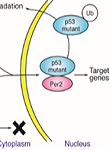|
|
|
Circadian-tumor suppressor crosstalk: Emerging opportunities in cancer chronotherapy
|
|
|
|
|
|
|
|
|
|

|
|
|
|
Tetsuya Gotoh, Xianlin Zou, Carla V. Finkielstein
|
|
|
|
Virginia Tech, and Osaka University
|
|
Biocomplexity Institute, Virginia Tech, Blacksburg, VA, USA.
Institute for Protein Research, Osaka University, Osaka, Japan
|
|
finkielc@vt.edu
|
|
|
|
|
|
|
|
|
|

|
|
Previously, cancer treatment modalities relied primarily on chemotherapeutic agents; nowadays, advances in rationally-designed drugs and targeted therapies have enabled the manipulation of cancer-specific regulatory molecules that are frequently mutated and globally identified in various cancers. Regardless the approach, the objective for controlling cancer progression has always been to attenuate, eliminate, or control the neomorphic activity of target driver mutations in tumors by maintaining steady levels of therapeutic agents. As precision medicine gains momentum, so does the possibility of customizing individual patients’ treatments to the “time-of-day” when tumor cells exhibit the highest susceptibility to therapeutics (1). However, a gap exists in our knowledge regarding the times at which therapeutically-targeted molecules are likely to be most susceptible to drugs and yield the greatest cellular effect. As a result, there is a need to unveil “when” and “where” druggable targets are in the cell and “to what extent” the tumor’s time-keeping system differs from normal tissue (Fig. 1A). Defining priorities that address those needs across the hierarchical system of organization will allow researchers to find the best time-windows where delivery of treatment modalities can be most effective.
|
|
|
|
|
|
|
|

|
|